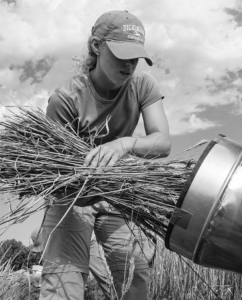 Plant Breeding and the Future of Food
Plant Breeding and the Future of Food
Jamie Bugel ‘13 grew up all over the country, from Virginia, to Kentucky, to Wisconsin, to Georgia, to Florida.

Embryo rescue is a technique that allows breeders to make crosses that might not want to happen very easily in a natural environment
For the first decade of her life, her grandparents owned a small farm in Virginia, which backed up to the Blue Ridge Mountains and Shenandoah National park and had a range of animals and a large garden. As a child, her idea of what she wanted to be when she grew up was constantly changing, from a doctor, to spy, economist, though perhaps living and visiting all of these places, exposing her to many different climates and plants sparked her interest in plant species, resulting in her pursuing a graduate degree in Plant Breeding and Agroecology today.
While applying to Dickinson, Jamie had heard of the College Farm but it was not a large part of her reasons for applying to the college. As a student, she was a biology major and volunteered on the farm every once in awhile, but was not an employee of the college farm until after graduation. She feels very fortunate that the farm opened up the apprenticeship to all students.
During her apprenticeship, the opportunity to wake up with the sun and become more acquainted with the different areas of the farm excited her for work every day, her favorite farm chore was harvesting. She says “I really enjoyed thinking about the people who were going to turn all the vegetables into delicious meals (ourselves included)”. Her favorite crop to harvest was, understandably, strawberries, though she admits she probably tried to save a few too many overripe ones by eating them. One of her other favorite memories of the farm was building the boats for the “Anything That Floats” boat races in Boiling Springs on the Fourth of July, she loved being able to build a stronger sense of comradery among the crew through such a unique task. At the end of the day, one of her (many) favorite spots on the farm was the woodlot, as the path up to it allowed for a beautiful view of almost the entire farm.
After completing her apprenticeship with the farm, Jamie moved to Salina, Kansas, to work as a research technician at the Land Institute, where she worked with perennial wheat. She is thankful for the experience that she received at Dickinson, as working in Professor Roberts’ cancer research lab and the genetic techniques that she learned there were the same or very similar to the basis techniques she used at the Land Institute. She is thankful for the work ethic that she learned at the College Farm, allowing her to be able to work long hours in the Kansas weather as well as being able to thrive while doing the lab work required in plant breeding. For more information on the Land Institute and the work that she did with perennial wheat, check out this documentary.
Today, Jamie is attending grad school at the University of Wisconsin, pursuing degrees in Agroecology and Plant Breeding. When asked if working at the College Farm influenced her getting to this point, she replied “mightily” and began reminiscing about the first time that she ate farm fresh food and how it could not be compared to that of the

Making crosses to breed intermediate wheatgrass aka Kernza (intermediate wheatgrass was actually first evaluated and identified as a good candidate for domestication as a perennial grain at Rodale, yay PA!)
produce sold in grocery stores. Her work allows her to reflect on the consequences of industrial agriculture on landscape, climate and human health and how the College Farm has shaped her desire to spend her life working and living in a way that allows everyone a chance to eat sustainably grown food. She applies her knowledge of how farms and farmers work to the experiments that she sets up in lab and she always keeps the needs of the consumers in mind when developing new varieties of vegetables and grains.
Needless to say, Jamie is still very involved in the food industry, as she is interested in plant breeding’s ability to be a driver for improving our agricultural system. She is currently working in Bill Tracy’s Sweet Corn breeding lab, where she is focusing on breeding more savory varieties of sweet corn. This project hopes to develop more varieties of sweet corn from heirloom varieties that will allow for uses in many different recipes, from soups to roasting elotes. Inspiration for this project comes from the variety of ways that South and Central American cultures incorporate corn into their cuisine, with the ultimate goal being to create varieties that are regionally adapted to Wisconsin.

Three varieties of heirloom corn Jamie is currently working on making taste “cornier” and have stronger stalks and pest/disease/ weather resistance, trying to make the varieties heartier without losing the amazing heirloom flavor. From left to right: Lindsey-Meyer Blue, Howling Mob, Golden Bantam.
Jamie’s graduate program affords her the opportunity to be directly involved in the local foods movement through a program called the “Seed to Kitchen Collaborative”. This program allows her to work with local farmers and chefs to develop and assess different varieties of vegetables and produce that are regionally adapted to the upper great lakes region. The collaboration helps facilitate a regional “taste” and works towards creating an environment where locally produced food is both desired and attainable across all socioeconomic levels.
We are so very proud of the work that Jamie is doing for this country’s food system and are elated to have been a part of her journey. Keep up the great work, Jamie!

Leave a Reply